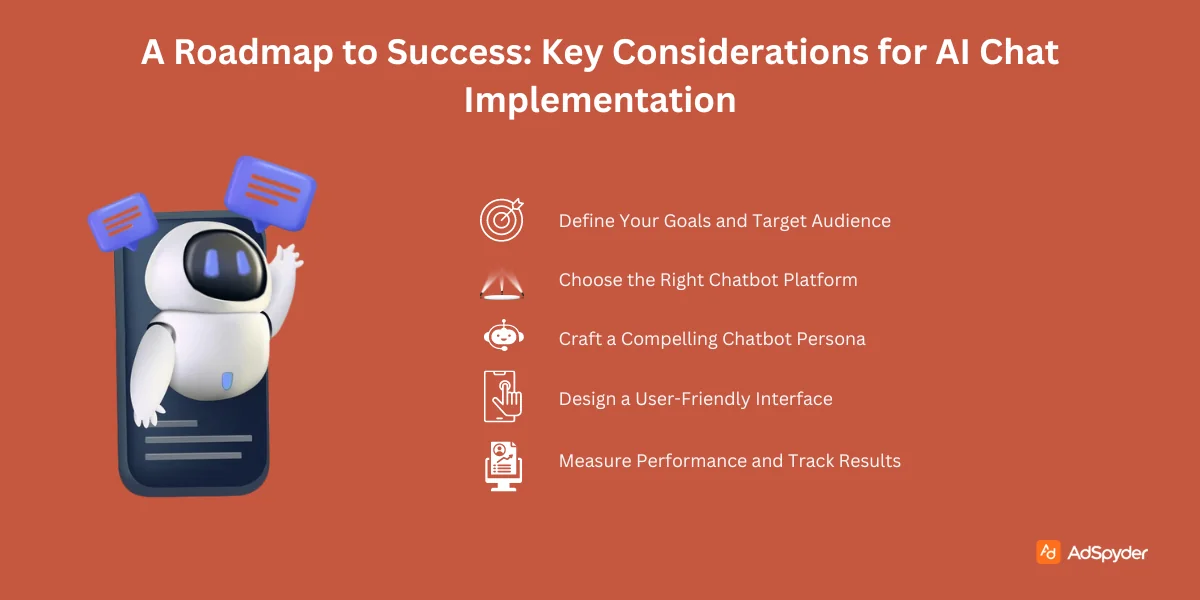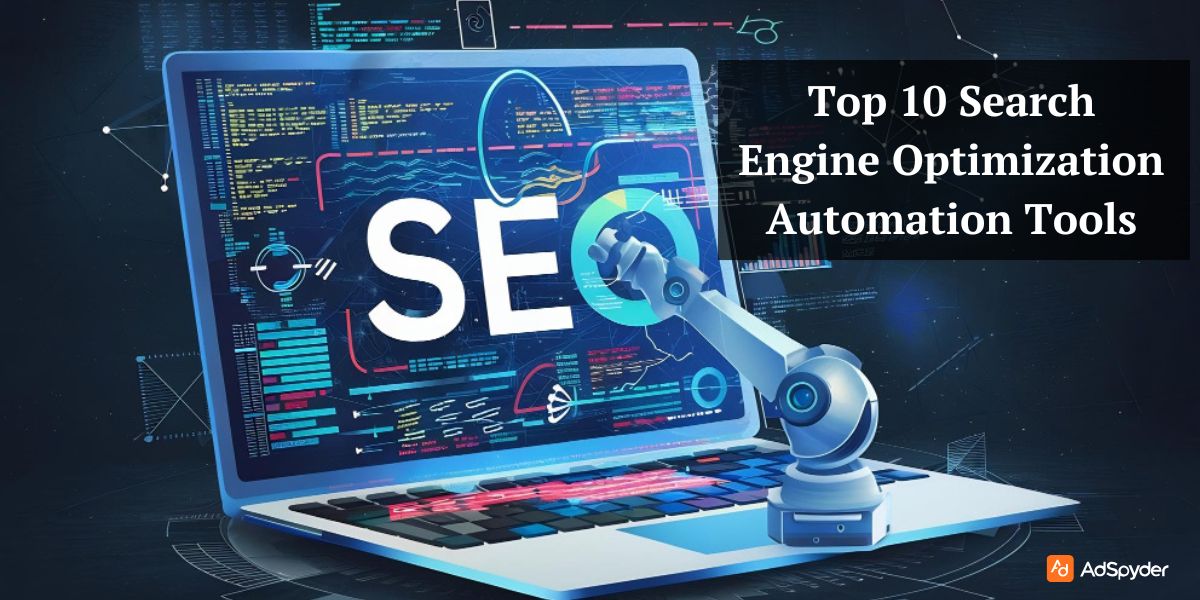The world of online interactions is rapidly evolving. Gone are the days of static websites and clunky email forms. Today, businesses are increasingly turning to AI chatbots to enhance customer experience, streamline communication, and boost conversions. However, simply integrating an AI chatbot into your website isn’t enough. To truly reap the benefits of this technology, you need a strategic implementation plan. This blog post delves into the best practices for Implementing AI Chat Online. We’ll explore key considerations throughout the entire process, from defining your goals to measuring success. By following these best practices, you can ensure your AI chatbot becomes a valuable asset in your online communication strategy.
Ready to Elevate your Marketing Strategy?
What is AI Chatbot?

An AI chatbot is a software application that uses artificial intelligence (AI) and natural language processing (NLP). Using these, they can simulate human-like conversations with users. These chatbots can understand user queries and provide relevant responses. These can even learn over time to improve interactions. These chatbots are being used in multiple industries for simple tasks. Some of them include answering queries that frequently arise in the users and providing step-by-step guide for performing desired tasks.
Unlike rule-based bots, AI chatbots adapt to language variations, context, and user behavior. This makes them ideal for customer support, lead generation, onboarding, and more. They can be integrated into websites, messaging apps, and mobile platforms to provide 24/7 assistance and enhance user engagement. Nowadays, many websites are tapping into this technology for improving user experience. The implementation side may require the know how of some tools. But once it is up and running, it can be a gamechanger.
Benefits of AI Chatbots for Businesses
| Benefit | Description | Business Impact |
| 24/7 Availability | Chatbots can operate round the clock without breaks. | Improved customer service & global reach |
| Instant Response Time | AI bots handle queries in real-time, reducing wait time. | Higher user satisfaction and retention |
| Cost Efficiency | Reduces the need for large customer support teams. | Significant savings on support operations |
| Scalability | Easily handles thousands of simultaneous conversations. | Supports growth without added overhead |
| Personalized Experience | Uses customer data to deliver tailored responses and suggestions. | Boosts engagement and conversion rates |
| Data Collection | Gathers user behavior and feedback during conversations. | Informs product, sales, and marketing strategies |
| Multilingual Support | Communicates with users in their preferred language. | Expands global customer reach |
| Lead Qualification | Identifies and nurtures potential leads automatically. | Increases sales pipeline efficiency |
AI Chatbot Use Cases by Industry
| Industry | Use Cases | Benefits |
| E-commerce | Product recommendations, order tracking, cart reminders | Boost sales, reduce cart abandonment |
| Healthcare | Appointment booking, symptom checking, patient FAQs | 24/7 support, reduced admin workload |
| Banking & Finance | Account inquiries, fraud detection alerts, balance checks | Fast service, enhanced customer trust |
| Education | Course FAQs, virtual tutors, enrollment assistance | Personalized learning, instant info |
| Travel & Hospitality | Booking confirmations, itinerary updates, customer support | Streamlined booking, improved experience |
| SaaS / Tech | Onboarding guides, support ticketing, feature explanations | Lower churn, better user experience |
| Real Estate | Property suggestions, lead qualification, appointment setting | Better engagement, lead conversion |
| HR & Recruitment | Screening candidates, interview scheduling, answering FAQs | Saves time, improves hiring funnel |
A Roadmap to Success: Key Considerations for Implementing AI Chat Online

Define Your Goals and Target Audience
The idea behind defining goals and target audiences is to hone in on what you want to achieve and who your ideal customer is.
- It is always important to have goals well set when starting a new product and this is the first activity to undertake.
- What are you expecting to accomplish through the incorporation of the AI chat options?
- Widely used aims involve enhancing the availability and quality of customer support, reducing work with low-added value, or creating new sales leads.
- There are also other requirements, which you should know your target audience and what they may expect from a chatbot conversation.
To do this, it would be useful to outline this information at the beginning so that there is a clear set of goals to work towards and to define success later on.
Choose the Right Chatbot Platform for Implementing AI Chat Online
Having thus clear goals in mind, it is possible to begin with the assessment of the numerous and diverse chatbot development platforms available.
- Some of the factors to consider are usability, adaptability, expandability, interoperability, and security.
- Make sure you spend enough time trying out the options in terms of the primary uses for which you want to employ the tool/program.
Check Out: The Future of Artificial Chat
Craft a Compelling Chatbot Persona
Here, the key determinant of user perceptions and their willingness to engage in a conversation with your chatbot will lie in its personality.
- Decide on the name, gender, and the type of voice and speaking manner your bot should have, as well as an avatar.
- Bots with positive charisma that provide some light humor or compassion are usually well received, though this depends on your company’s image and consumers.
- Role-play sample conversations and look for an authentic persona that resonates within each unique role.
Design a User-Friendly Interface
Perhaps, even possessing the most sophisticated AI, a chatbot needs an understandable interface for customers to use it.
- Take time and think about the positioning of chat widgets within a website.
- Also think about the circumstances under which they will appear.
- It is crucial to understand that the process of getting the right and perfect UI is a continuous process of enhancement. Expect such changes to be made frequently.
Train Your Chatbot for Success

Although it is possible to use templates that have been created in advance, this is not always effective for using the chatbot for regular FAQs and initial conversations. This is why training is crucial.
- Expose your bot to diverse conversational data and some actual customer questions or queries about your products/ services.
- The intents must be very clearly outlined to help control and manage dialog flows and to plan out comprehensive responses for each one.
- Also provide information gathered from your existing ad campaigns that possess data relevant to the audiences (eg. DCO Ads).
Integrate Seamlessly with Existing Systems
Your chatbot should have access to other organizational data.
- This includes customer databases, product databases, and the API for orders. Integrating with these backend systems enables your bot to handle more distinct and individual questions that are more than just surface level.
- Extensions to contact center software, e-commerce platforms, CRMs, analytics, and even more can enhance possibilities.
- Data access also affects other features such as account search and the ability to place orders through the chatbot.
- Showcase your AI chatbot by running native ad campaigns and allow users to go to the chatbot without having to exit their app or webpage.
- You can also promote the chatbot by creating interactive videos that integrate this chatbot for users to try it out. This also increases additional avenues of testing.
Prioritize Security and Data Privacy
When dealing with sensitive customer information, it is always wise to give security a top priority.
- Carry out comprehensive risk assessments to search for threats in your chatbot application, database, and connection with other systems.
- This should be accompanied by proper authentication measures, using coded language when transferring data, and proper restricted access.
Gather User Feedback and Continuously Improve
The process in creating and implementing a chatbot does not end once your chatbot is out on the field.
- Nevertheless, the ‘real’ process of refinement begins then in a cycle of continuous customer feedback.
- This is where the chat transcript should be reviewed to assess where the conversation turns ugly.
- Review utilization statistics to pinpoint intents that receive little to no engagement.
- Periodically, send questionnaires to gather Direct user feedback that involves complaints and suggestions to create the foundation for direct user feedback that defines major improvements over time with enhanced NLP retraining.
Measure Performance and Track Results for Implementing AI Chat Online
- Make sure to introduce corresponding success indicators to measure once you define clear objectives for your conversational AI at the preliminary stage.
- Some numbers could represent the percentage of conversation they contain, the average time it takes us to reply, the number of users we assist in a given session, or the number of sales we support in a given month.
Common Mistakes to Avoid while using AI Chatbots
| Mistake | Why It’s a Problem | How to Avoid It |
|---|---|---|
| No Clear Goal or Strategy | Leads to poor implementation and user confusion | Define chatbot purpose and KPIs upfront |
| Over-Automation Without Human Handoff | Frustrates users when bots can’t handle complex queries | Provide easy access to live agents when needed |
| Lack of Training Data | Reduces chatbot accuracy and usefulness | Feed real customer interactions to train the AI |
| Ignoring User Intent | Bots may misunderstand what users really want | Use NLP to understand context and conversation flow |
| Too Much Jargon or Formality | Makes the conversation feel robotic or impersonal | Keep language natural, conversational, and brand-aligned |
| No Feedback Loop | Misses opportunities to improve performance | Collect user feedback and monitor chatbot logs |
| Poor Error Handling | Creates dead ends when the bot doesn’t understand something | Add fallback responses and rephrasing options |
FAQs
The cost and complexity of AI chatbot implementation vary depending on the platform you choose and the functionalities required. However, advancements in technology have made AI chatbots more accessible and affordable for businesses of all sizes.
Regularly update your chatbot’s training data with the latest information and industry trends. Integrate the chatbot with your knowledge base or CRM system to ensure access to accurate and real-time data.
A fallback mechanism should be implemented in a well-designed AI chatbot. This could involve offering users the option to connect with a live customer service representative, suggesting relevant FAQs, or redirecting them to a specific webpage with the desired information.
Utilize a diverse and unbiased dataset for training your AI chatbot. Monitor the chatbot’s responses for any signs of bias and adjust the training data accordingly. Regularly review user feedback to identify potential areas of bias.
Integrate your chatbot with your CRM system. This allows the human agent to access the chat history and understand the user’s previous interactions with the chatbot. Train your customer service representatives on how to effectively handle handoff situations and ensure a positive customer experience.
Conclusion
The landscape of online interactions is undergoing a paradigm shift. AI chatbots are no longer a futuristic concept. They are a powerful tool with the potential to enhance customer experience, streamline communication, and drive business growth.
By following the best practices outlined in this blog post, you can ensure your AI chatbot implementation is successful and delivers tangible results. Remember, the future of online interactions is undoubtedly conversational. By embracing AI chatbots strategically, you can position your business at the forefront of this era in online communication.




